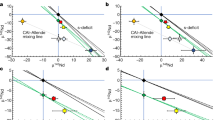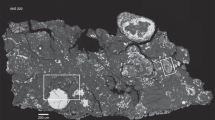Abstract
Primitive meteorites (such as the unequilibrated ordinary chondrites) have undergone only minor thermal processing on their parent asteroids, and thus provide relatively unaltered isotopic records from the early Solar System. For terrestrial materials, oxygen isotope compositions form a linear array called the terrestrial fractionation line1. In meteorites the oxygen isotopic composition commonly deviates from this line2, the magnitude of the deviation being expressed by the quantity Δ17O. Such deviations, which cannot be explained by mass-dependent fractionation processes, are probably caused by the mixing of two or more nebular components having different nucleosynthetic histories, for example, solids and gas. But no direct evidence for the oxygen isotopic composition of the latter (which is the dominant oxygen reservoir) has hitherto been available. Here we report in situ oxygen-isotope measurements of magnetite grains in unequilibrated ordinary chondrites. Magnetite (which formed by aqueous alteration of metal in the parent asteroid) may serve as a proxy for nebular H2O. We measured a value of Δ17O ≈ 5‰, much higher than typical values of 0–2‰ in ordinary-chondrite silicate grains. Our results imply that a nebular component of high-Δ17O H2O was incorporated into the parent asteroid of the unequilibrated ordinary chondrites.
This is a preview of subscription content, access via your institution
Access options
Subscribe to this journal
Receive 51 print issues and online access
$199.00 per year
only $3.90 per issue
Buy this article
- Purchase on Springer Link
- Instant access to full article PDF
Prices may be subject to local taxes which are calculated during checkout



Similar content being viewed by others
References
Clayton, R. N. Oxygen isotopes in meteorites. Annu. Rev. Earth Planet. Sci. 21, 115–149 (1993).
Clayton, R. N., Onuma, N., Grossman, L. & Mayeda, T. K. Distribution of the presolar component in Allende and other carbonaceous chondrites. Earth Planet. Sci. Lett. 34, 209–224 (1977).
Clayton, R. N., Grossman, L. & Mayeda, T. K. Acomponent of primitive nuclear composition in carbonaceous meteorites. Science 182, 485–488 (1973).
Clayton, R. N., Onuma, N. & Mayeda, T. K. Aclassification of meteorites based on oxygen isotopes. Earth Planet. Sci. Lett. 30, 10–18 (1976).
Clayton, R. N. & Mayeda, T. K. The oxygen isotope record in Murchison and other carbonaceous chondrites. Earth Planet. Sci. Lett. 67, 151–161 (1984).
Morioka, M. Cation diffusion in olivine, I. Cobalt and magnesium. Geochim. Cosmochim. Acta 44, 759–762 (1980).
Ryerson, F. J., Durham, W. B., Cherniak, D. J. & Lanford, W. A. Oxygen diffusion in olivine: Effect of oxygen-fugacity and implications for creep. J. Geophys. Res. 44, 4105–4118 (1989).
Krot, A. N.et al. Carbide-magnetite assemblages in type-3 ordinary chondrites. Geochim. Cosmochim. Acta 61, 219–237 (1997).
Hutchison, R., Alexander, C. M. O. & Barber, D. J. The Semarkona meteorite; First recorded occurrence of smectite in an ordinary chondrite, and its implication. Geochim. Cosmochim. Acta 51, 1875–1882 (1987).
Grossman, J. N. Semarkona: The least metamorphosed ordinary chondrite. (abstr.) Meteoritics 20, 656–657 (1985).
Sears, D. W. G., Hasan, E. A., Batchelor, J. D. & Lu, J. Chemical and physical studies of type 3 chondrites — XI: Metamorphism, pairing, and brecciation of ordinary chondrites. Proc. Lunar Planet. Sci. Conf. 21, 493–512 (1991).
Choi, B.-G., McKeegan, K. D., Leshin, L. A. & Wasson, J. T. Origin of magnetite in oxidized CV chondrites: in situ measurement of oxygen isotope compositions of magnetite and olivine in CV3 Allende. Earth Planet. Sci. Lett. 146, 337–349 (1997).
Clayton, R. N., Mayeda, T. K., Goswami, J. N. & Olsen, E. J. Oxygen isotope studies of ordinary chondrites. Geochim. Cosmochim. Acta 55, 2317–2337 (1991).
Huss, G. R., Fahey, A. J., Gallino, R. & Wasserburg, G. J. Oxygen isotopes in circumstellar Al2O3grains from meteorites and stellar nucleosynthesis. Astrophys. J. 430, L81–L84 (1994).
Nittler, L. R., Alexander, C. M. O'D., Gao, X., Walker, R. M. & Zinner, E. K. Interstellar oxide grains from the Tieschitz ordinary chondrite. Nature 370, 443–446 (1994).
Saxton, J. M., Lyon, I. C., Turner, G. & Hutchison, R. Oxygen isotopes in Semarkona magnetite. (abstr.). Meteoritics 30, 572–573 (1995).
Shimizu, N. & Hart, S. R. Isotope fractionation in secondary ion mass spectrometry. J. Appl. Phys. 53, 1303–1311 (1982).
Rowe, M. W., Clayton, R. N. & Mayeda, T. K. Oxygen isotopes in separated components of Cl and CM meteorites. Geochim. Cosmochim. Acta 58, 5341–5347 (1994).
Jarosewich, E. Chemical analyses of meteorites: A compilation of stony and iron meteorite analyses. Meteoritics 25, 323–337 (1990).
Savin, S. M. & Lee, M. Isotopic studies of phyllosilicates. Rev. Mineral. 19, 189–223 (1988).
Palme, H. & Boynton, W. V. in Protostars and Planets III(eds Levy, E. & Lunine, J. I.) 979–1004 (Univ. Arizona Press, Tucson, (1993).
Acknowledgements
We thank C. Coath, G. Jarzebinski and L. Leshin for technical assistance with the ion microprobe, A. Rubin for petrological advice and S. Savin and R. N. Clayton for discussions. Reviews by G. Huss and B. Giletti led to improvements in the manuscript. The Semarkona and Ngawi thin sections were provided by G. MacPherson (Smithsonian Instn) and A. Brearley (Univ. New Mexico).
Author information
Authors and Affiliations
Corresponding author
Rights and permissions
About this article
Cite this article
Choi, BG., McKeegan, K., Krot, A. et al. Extreme oxygen-isotope compositions in magnetite from unequilibrated ordinary chondrites. Nature 392, 577–579 (1998). https://doi.org/10.1038/33356
Received:
Accepted:
Issue Date:
DOI: https://doi.org/10.1038/33356
This article is cited by
-
Oxygen isotope evidence from Ryugu samples for early water delivery to Earth by CI chondrites
Nature Astronomy (2022)
-
Oxygen Isotopes and Sampling of the Solar System
Space Science Reviews (2020)
-
What is the Oxygen Isotope Composition of Venus? The Scientific Case for Sample Return from Earth’s “Sister” Planet
Space Science Reviews (2020)
-
Water Reservoirs in Small Planetary Bodies: Meteorites, Asteroids, and Comets
Space Science Reviews (2018)
-
In situ SIMS oxygen isotope analyses: Evidence for the formation of aluminum-rich chondrules from ordinary chondrites
Science China Earth Sciences (2015)
Comments
By submitting a comment you agree to abide by our Terms and Community Guidelines. If you find something abusive or that does not comply with our terms or guidelines please flag it as inappropriate.



